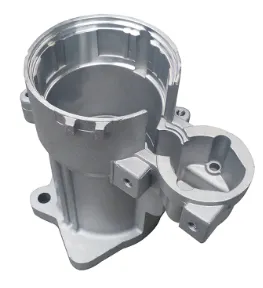Móvil:+86-311-808-126-83
Correo electrónico:info@ydcastings.com
From Cast Iron to Aluminum: The Evolution of Oil Pans
El motor housing, engine oil pan, y automobile oil pan are critical components in vehicle design, ensuring lubrication, heat dissipation, and debris protection. Over the decades, these parts have undergone significant material and engineering advancements. Initially made from heavy hierro fundido, oil pans have transitioned to lightweight aluminum alloys, improving fuel efficiency and durability. This article explores the evolution of automobile oil pans, highlighting key innovations, manufacturing techniques, and future trends.
In the early days, hierro fundido was the dominant material due to its robustness and ability to withstand extreme temperatures and pressures. However, hierro fundido oil pans were heavy, which negatively impacted fuel efficiency. As automotive technology progressed, engineers began searching for alternative materials that could offer similar durability but with reduced weight. Aluminum alloys emerged as a suitable substitute, offering a significant weight reduction while maintaining the necessary strength and corrosion resistance. The shift to aluminum alloys was a pivotal moment in the history of automobile oil pans, marking the beginning of a new era of innovation and efficiency.

Early Designs: Cast Iron Dominance
The earliest engine oil pans were constructed from hierro fundido due to its durability and heat resistance.
- Strength and Durability: Cast iron provided excellent impact resistance, protecting the engine from road debris.
- Heat Retention: Its high thermal mass helped stabilize oil temperatures in early combustion engines.
- Manufacturing Limitations: Heavy weight and complex casting processes made these automobile oil pansless efficient over time.
As engines became more advanced, the need for lighter materials led to the rise of aluminum oil pans.
Aluminum Revolution: Lightweight Efficiency Cast Iron
The shift from hierro fundido to aluminio marked a major leap in engine oil pan technology.
- Weight Reduction: Aluminum is significantly lighter, improving fuel economy and handling.
- Better Heat Dissipation: Unlike cast iron, aluminum disperses heat quickly, preventing oil degradation.
- Corrosion Resistance: Modern alloys resist rust, extending the lifespan of automobile oil pans.
Precision casting techniques, such as those used by , ensure high-quality, defect-free aluminum oil pans with superior structural integrity.
Modern Manufacturing Techniques Cast Iron
Advanced production methods have refined engine oil pan performance and reliability.
- Fundición a presión de alta presión: Ensures precise, repeatable designs with minimal porosity.
- Sand Casting: Used for complex, low-volume automobile oil pandesigns.
- CNC Machining: Provides tight tolerances for optimal sealing and fitment.
Companies specializing in motor housing and oil pan production leverage these techniques to meet stringent automotive standards.
Future Trends in Engine Oil Pan Design
Innovations continue to shape engine oil pan development.
- Composite Materials: Carbon fiber-reinforced polymers may replace metals for further weight savings.
- Integrated Cooling Channels: Future automobile oil panscould feature built-in cooling fins or liquid cooling.
- Smart Sensors: Oil condition and level monitoring may become standard in next-gen designs.
These advancements align with the growing demand for efficiency in both traditional and electric vehicles.
FAQs About Automobile Oil Pans
What is the primary function of an engine oil pan?
El engine oil pan stores and circulates oil, ensuring proper lubrication and cooling of engine components.
Why did manufacturers switch from cast iron to aluminum?
Aluminum offers better weight savings, heat dissipation, and corrosion resistance compared to hierro fundido.
Can a damaged oil pan affect engine performance?
Yes, leaks or cracks in an automobile oil pan can lead to oil loss, overheating, and engine failure.
How are modern oil pans manufactured?
Techniques like high-pressure die casting and CNC machining ensure precision and durability in motor housing and oil pan production.
Will electric vehicles still use oil pans?
While EVs don’t need traditional lubrication, specialized cooling pans may emerge for battery and motor thermal management.
By understanding the evolution of automobile oil pans, we gain insight into how material science and engineering continue to drive automotive innovation. Companies like play a crucial role in advancing these technologies through precision manufacturing.
These advancements not only enhance performance but also improve fuel efficiency and reduce environmental impact. Innovations in oil pan design, such as integrated baffles and windage trays, further contribute to minimizing oil sloshing and drag, thereby optimizing engine operation. Additionally, the adoption of lightweight materials like aluminum alloys helps in reducing the overall weight of the vehicle, enhancing its energy efficiency.
Moreover, advancements in sealing technologies have significantly minimized oil leaks, ensuring that the engine operates smoothly and reduces the risk of component damage. Manufacturers are also incorporating smart sensors into oil pans to monitor oil levels and quality in real-time, facilitating predictive maintenance and extending engine lifespan. As environmental regulations become stricter, the trend towards eco-friendly oil pan designs, such as those with improved recyclability, is also gaining traction.
-
Materials Used in Manufacturing Cap End Pipe FittingsNoticiasNov.24,2025
-
Material Properties of CF8M CastingNoticiasNov.24,2025
-
How to Inspect Pump Cap Ends for DamageNoticiasNov.21,2025
-
Backward Curved Impeller – Efficient Airflow Solutions for Industry | YD CastingsNoticiasNov.21,2025
-
Automobile Water Pump - Efficient, Quiet, Durable & ElectricNoticiasNov.21,2025
-
Impeller for Pumps – High-Efficiency, Durable, OEM-ReadyNoticiasNov.21,2025











